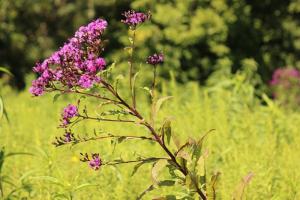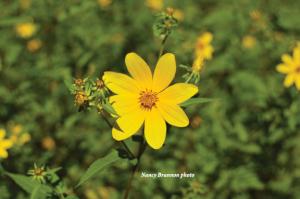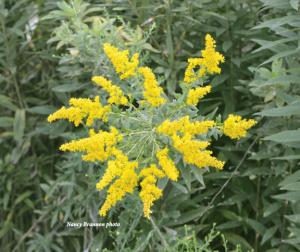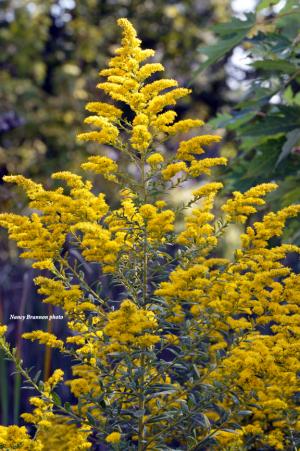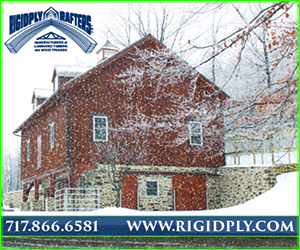Photos by Nancy Brannon
Engelmann’s Daisy
In September you may have seen this pretty yellow daily blooming in vast meadows underneath power line right-of-ways or alongside roadways. It is Engelmann’s Daisy (Engelmannia peristenia), a widespread native wildflower noted for its summer-long display of golden-yellow flowers. Engelmann's Daisy is a tough, resilient perennial that thrives in a wide range of climates and growing conditions. It is particularly seen in hot, poor soil planting conditions where it thrives with minimal care. It will re-seed itself and naturalize where conditions are right. It blooms early to late summer, attracts butterflies, and is bee friendly.
Engelmannia is somewhat unusual in that it is a monotypic genus, meaning it contains one species.
The genus of this plant is named for George Engelmann (1809-1884) who was born in Germany and settled in St. Louis, Missouri as a young man. He was a physician and botanist. When he died, much of his collection went to Missouri Botanical Garden.
Sources:
Lady Bird Johnson Wildflower Center, the University of Texas at Austin
High Country Gardens at www.highcountrygardens.com
USDA Plant Guide at: https://plants.usda.gov/plantguide/pdf/pg_enpe4.pdf
Ironweed
Ironweed is a member of the very large Aster family of plants that grows in the eastern half of North America. It is quite tall, growing up to 7 feet, and it has deep purple colored flowers, which bloom August to October. An excellent addition to the pollinator garden, the brilliant purple-crimson bloom color is very attractive to butterflies. Ironweed is a host plant for the American Painted Lady butterfly, as well.
The dark rigid stems topped with contrasting fluffy seed heads offer excellent late season color and texture. Although it grows naturally in moist soils, it also does equally well in average garden soils. In the Garden it is effective in background borders, cottage gardens, rain gardens, wildflower meadows and naturalized plantings.
Source: http://www.prairienursery.com
Goldenrod
Goldenrod is a perennial plant that is well-known for its healing properties. This wild edible reproduces through its roots, bulbs, stems, and by its seed. Goldenrod does not cause seasonal allergies; no one can be allergic to Goldenrod pollen because it has virtually none and it is pollinated by insects. Only wind-pollinated plants such as Ragweed (which blooms at the same time as Goldenrod) cause allergic reactions. Currently, there are 140 varieties of Goldenrod.
Source:
Edible Wild Food: Goldenrod http://www.ediblewildfood.com/goldenrod.aspx
Engelmann’s Daisy
In September you may have seen this pretty yellow daily blooming in vast meadows underneath power line right-of-ways or alongside roadways. It is Engelmann’s Daisy (Engelmannia peristenia), a widespread native wildflower noted for its summer-long display of golden-yellow flowers. Engelmann's Daisy is a tough, resilient perennial that thrives in a wide range of climates and growing conditions. It is particularly seen in hot, poor soil planting conditions where it thrives with minimal care. It will re-seed itself and naturalize where conditions are right. It blooms early to late summer, attracts butterflies, and is bee friendly.
Engelmannia is somewhat unusual in that it is a monotypic genus, meaning it contains one species.
The genus of this plant is named for George Engelmann (1809-1884) who was born in Germany and settled in St. Louis, Missouri as a young man. He was a physician and botanist. When he died, much of his collection went to Missouri Botanical Garden.
Sources:
Lady Bird Johnson Wildflower Center, the University of Texas at Austin
High Country Gardens at www.highcountrygardens.com
USDA Plant Guide at: https://plants.usda.gov/plantguide/pdf/pg_enpe4.pdf
Ironweed
Ironweed is a member of the very large Aster family of plants that grows in the eastern half of North America. It is quite tall, growing up to 7 feet, and it has deep purple colored flowers, which bloom August to October. An excellent addition to the pollinator garden, the brilliant purple-crimson bloom color is very attractive to butterflies. Ironweed is a host plant for the American Painted Lady butterfly, as well.
The dark rigid stems topped with contrasting fluffy seed heads offer excellent late season color and texture. Although it grows naturally in moist soils, it also does equally well in average garden soils. In the Garden it is effective in background borders, cottage gardens, rain gardens, wildflower meadows and naturalized plantings.
Source: http://www.prairienursery.com
Goldenrod
Goldenrod is a perennial plant that is well-known for its healing properties. This wild edible reproduces through its roots, bulbs, stems, and by its seed. Goldenrod does not cause seasonal allergies; no one can be allergic to Goldenrod pollen because it has virtually none and it is pollinated by insects. Only wind-pollinated plants such as Ragweed (which blooms at the same time as Goldenrod) cause allergic reactions. Currently, there are 140 varieties of Goldenrod.
Source:
Edible Wild Food: Goldenrod http://www.ediblewildfood.com/goldenrod.aspx
